figure 1
|

|
Vincent A. Carducci
Getting Over at the Office Performance Documentation, 1987 – 1989
Exhibition Announcement Card, 1989. Produced in conjunction with the
exhibition “Urbanology: Artists View Urban Experience”
Offset lithograph, 6” x 4”
All works from the collection of Nora Dillon. Photo of the Artist by Gordon Shelest
All works by Vincent A. Carducci unless otherwise noted. All Images courtesy of the artist and the Dillon Collection. |
Like most people in the arts, for many years I supported my artistic activities, along with the rest of my life, by holding down a day job. Corporate communications and advertising primarily in financial services was not such a bad gig, actually, and, in fact, were what I trained to do by having a dual major in graphic design and painting. For the last thirteen years of that time, I also mounted a performance piece, Getting Over at the Office, 1987-2000, whereby I recoded aspects of my daily work life as art through a series of artifacts and documents. Much of the documentation consists of news releases, sent out intermittently to a mailing list that grew with time. The performance was a gesture through which I sought to reclaim the time that had been appropriated from me by the capitalist system.
figure 2
|
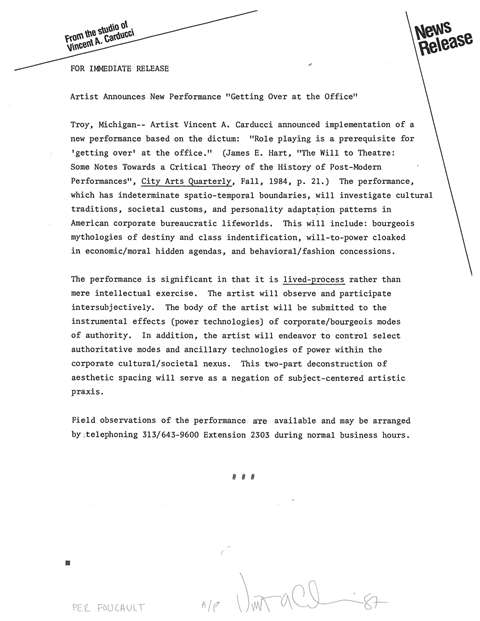
|
Per Foucault, 1987
photocopy
11” x 8 ½”
|
As I note in the inaugural news release, Per Foucault, 1987, the inspiration for the project came from a quote in an article on performance art by James E. Hart, published in a local art magazine: “Role playing is a prerequisite for ‘getting over’ at the office.” The release is written as a parody of “art speak” by using language misappropriated from critical theory to establish the project’s parameters. On one level, the project comments on the state of performance art, a lot of which at the time I believed, and, in fact, still believe, simply is just bad theater, dance, music, creative nonfiction or other genre as the case may be. Submerged within the narrative of the performance was also an admission of an ambition to indeed “get over,” to actually make it in the corporate world.
Whereas most performance art is virtual—that is to say play-acting within the privileged sphere of what philosopher and art critic Arthur C. Danto calls the artworld—my performance was for real. I set about slogging through the shit of the corporate bureaucracy and endeavor to come out on top. (In truth, this is what many of us feel we must do in this wretched world. As the bumper sticker reads: “I owe. I owe. It’s off to work I go.” One just tries to make the best of it). I did the performance in the late 1980s when appropriation was all the rage in the artworld. Again, I believed that my performance had a level of reality most appropriation art did not because I actually stole from the company—the time I spent writing the news releases and duplicating them, the stationery, envelopes, and postage used in mailing them out, the copy machines and computer technology necessary for production, and other resources, such as paper clips, computer disks, and anything else lying around the office. I might need to do the work. Another aspect of the performance is the question of identity: “Who is the ‘real’ Vince Carducci? Subversive artist? Office drone?” As Lacan teaches with regard to the decentered self, most famously in the essay in Ecrits on the mirror stage where he notes that the ego’s reflection of itself is always already a misrecognition, it can go either way.
figure 3
|
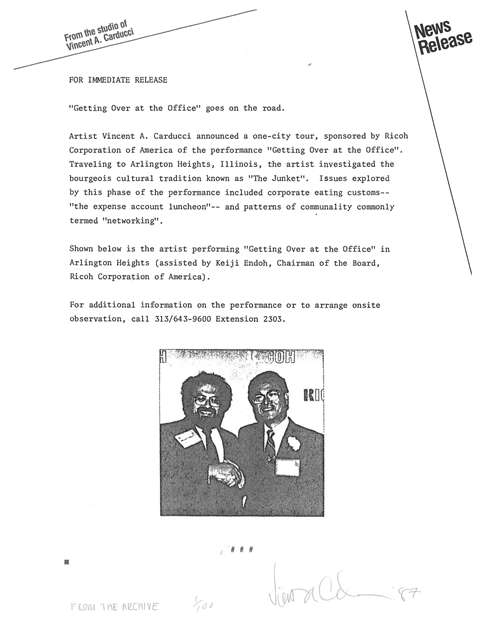
|
From the Archive, 1987
Photocopy
11” x 8 ½”
|
The second news release, “From the Archive” (1987), came shortly thereafter when
I traveled to suburban Chicago for a trade fair sponsored by the Ricoh Corporation. A guest of my Ricoh sales rep, I gorged myself on sushi and looked at the various types of imaging systems on display. For some reason, they photographed all their clients in a line next to Ricoh’s CEO, which I thought was a kind of wacky thing to do. I mean, neither a celebrity or war hero, he was just a guy in bad suit. As I stood there shaking hands with him, I envisioned the caption for the photo that would accompany the news release: “Shown is the artist performing ‘Getting Over at the Office’ (assisted by Keiji Endoh, chairman of the board, Ricoh Corporation of America).” And with that the performance was truly on its way.
figure 4
|
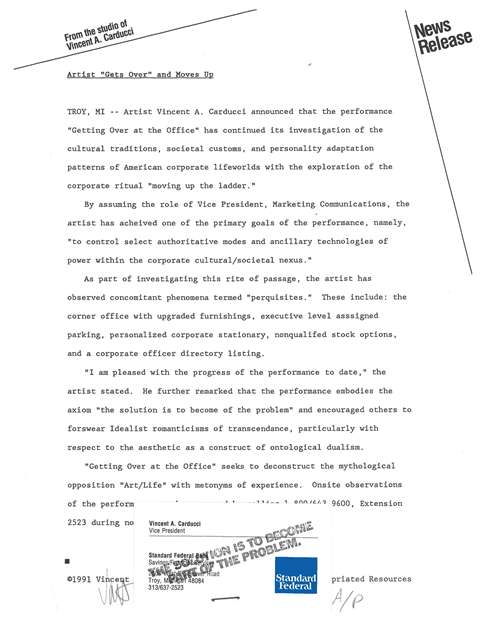
|
Moving Up the Ladder, 1991
photocopy, business card, staple, rubber stamp ink
11” x 8 ½”
|
figure 5
|
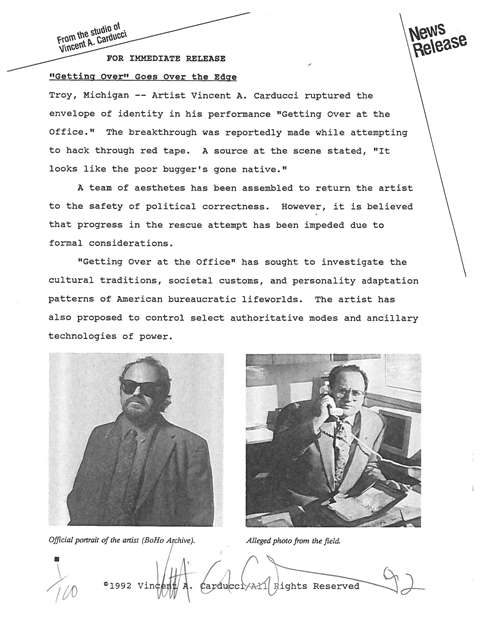
|
Getting Over’ Goes Over the Edge, 1992
photocopy
11” x 8 ½”
|
figure 6
|

|
‘Getting Over’ Goes Over the Edge (detail)
|
Over the course of the next thirteen years, documentation was released to mark sundry, noteworthy events. Every time I received a title change, for example, a release would disseminate with my new business card attached and a detail of what the new status entailed—stock options, an assigned parking space, a bigger office, etc. Sometimes the news release provided a convenient cover for what sociologists call role strain, the stress experienced when behavior, expectations, or obligations are associated with performing a social role conflict with one’s basic sense of self. An example of this is the release carrying the headline “‘Getting Over’ Goes Over the Edge” (1992) documenting my decision, years in the making as an aging hippie, to shave my beard in order to better fit into the expected look of a bank executive, again calling identity into question. Others documented some of the odd rituals of corporate life including, for example, the first time the CEO invited me to address him by his first name instead of “Mr. So-and-So Big Shot,” which became the subject of the release “‘Getting Over’ Artist Gets Inside” (1993).
figure 7
|
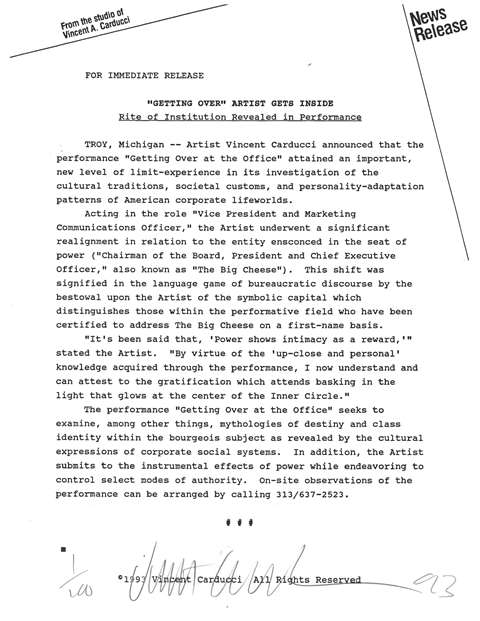
|
‘Getting Over’ Artist Gets Inside, 1993
photocopy
11” x 8 ½”
|
figure 8
|
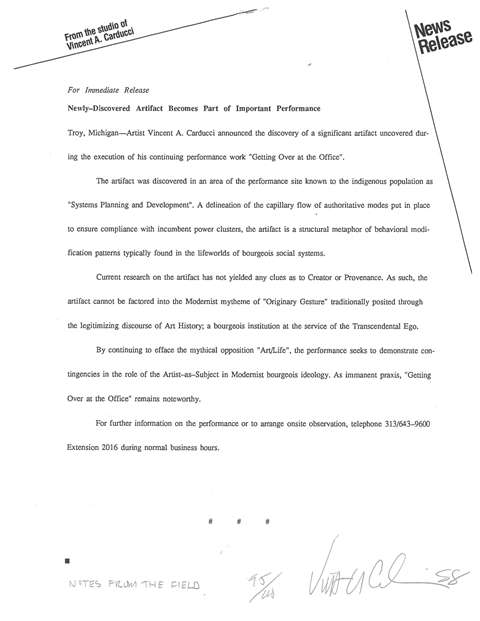
|
Notes From the Field, 1988
|
figure 9
|
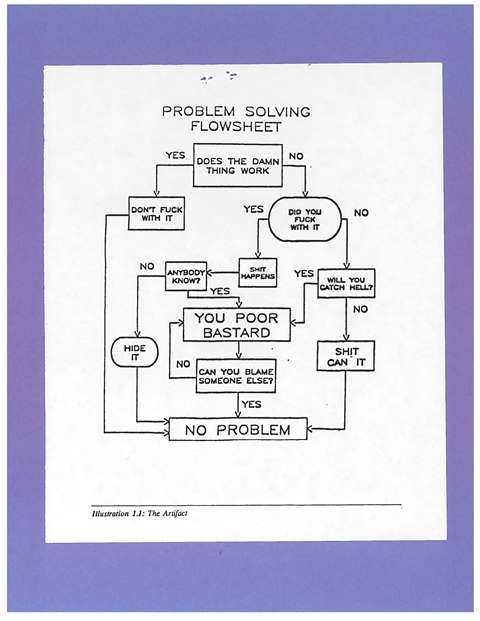
|
anonymous
Problem-Solving Flowsheet, n.d.
photocopy
9” x 7”
|
One of my favorite news releases is the one titled Notes From the Field, 1988. It documents the time I was in the Systems Planning and Development department and came across an illustration posted on the wall of an analyst’s cube. Titled “Problem-Solving Flowsheet,” the illustration mimicked the flow charts that business analysts use to document the steps of a work process. These charts have been used since the beginnings of industrial management theory in the nineteenth-century to plan and achieve the supposedly most rational and efficient results of any task. In this case, it sardonically documents the steps of the avoidance of consequences for the poor saps stuck in so-called rationalized management structures where, as they say, “no good deed goes unpunished.” It had obviously been photocopied several times so who knows where it came from or where it may have been distributed. I believed, and still do, that it exemplifies true folk art and that it says more about the plight of the worker bee than any self-satisfied diatribe of a highfalutin postmodernist artist who had never experienced the no-win situation most people experience in large bureaucracies. The “Problem-Solving Flowsheet” continues to circulate around the Internet in a cleaner, digitized version as a PDF.
Besides sending out documentation to the mailing list, I encouraged people to visit the performance in situ. Several people did and they typically received what marketers call “trinkets and trash,” giveaway items—pocket calculators, brochures, and other logo-imprinted items—I had designed as part of my job as the bank’s brand steward. I duly signed each of these in my capacity as artist, and if there was enough room, stamping them with the phrase “The Solution is to Become Part of the Problem,” which was the performance’s tag line. One of the people who did a site visit was noted Detroit collector, DIA and Cranbrook trustee, and art consultant Mary Denison, who also bought the bank’s stock simply because I had designed the certificate. Mary never got the physical certificate since the stock was held in what’s called “street name,” a method whereby brokers hold securities electronically to facilitate recordkeeping and transaction clearing. I fixed that when I gave her a copy of a cancelled certificate for her 60th birthday under what I called the “Universal Gift to Collector’s Act” that entitled her to a “piece of the action.” After Mary’s death, the certificate went to her long-time partner, the sculptor Gary Kulak, who still has it hanging in his office as far as I know.
Documentation of the performance was shown, along with two videos, in 1989 as part of the multi-site exhibition “Urbanology: Artists View Urban Experience.” Two years later, artist and critic Virginia Maksymowicz wrote about it as part of an article on art dealing with business for the California-based magazine High Performance. Joy Hakanson Colby, Detroit News art critic who was also on the mailing list, subsequently read about the High Performance article and pitched a story to her editor about it. In 1992, she wrote a major feature article on the performance, “"The Art of the Real." that was on the front page of the Arts section. By that time, I was high enough in the corporate chain of command that the article was viewed as positive PR for the bank and not some scandal, which it certainly would have had it come out a few years earlier. Our CEO, “Tom” as I called him, was a collector and trustee of the Detroit Symphony Orchestra, and he knew many of the people in the Detroit artworld who, although they were not all aware of my performance, certainly knew who I was as an exhibiting artist and, more importantly, a critic who published nationally. Many high-net-worth individuals are, of course, movers and shakers in the arts. In my case, the two worlds comfortably collided as I often gave tours of the bank’s contemporary art collection to current and potential private banking clients, including regaling them with art talk over an expense-account lunch in the executive dining room. At that point, among my duties was serving as Tom’s personal ghostwriter, and, therefore, repudiating me would have been a tremendous embarrassment for him. Instead, following Tom’s lead, people around the office congratulated me on being such a shining example of the bank’s diverse work force.
The performance gained a level of artworld legitimacy with its inclusion in the
Franklin Furnace Archives, now part of the Museum of Modern Art in New York City. I also turned one of the video narratives, detailing my experience upon entering the junior executive ranks of receiving tie-tying lessons in the men’s room by not one but two senior vice presidents, into a piece of creative nonfiction published by the webzine PopMatters under the title “Ties That Bind.” Ironically, as much as the performance was a doubled-edged deconstruction of the art and corporate worlds, it also became my plan for success. Whenever confronted with role strain, I could simply and literally call it part of the performance, sending out a news release as a form of confession and then do what I needed to do. I am thoroughly convinced that it had a material effect on my actually getting over at the office by becoming Senior Vice President-Director of Marketing and Corporate Communications, the top job in my area reporting to the CEO.
figure 10
|
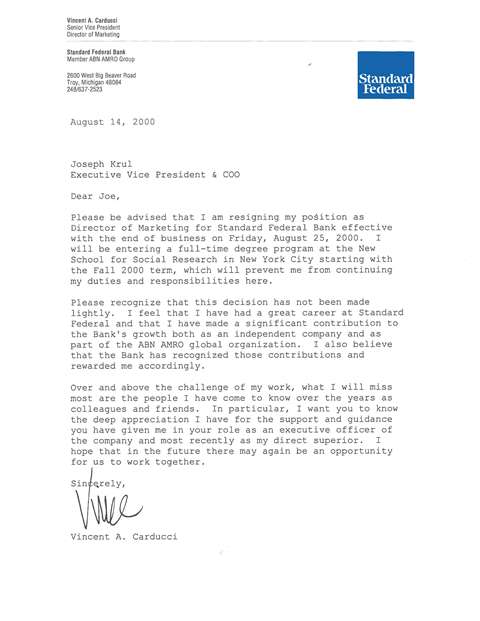
|
‘Getting Over’ Over and Out, part 1, 2000
laser print on letterhead
11” x 8 ½”
|
figure 11
|
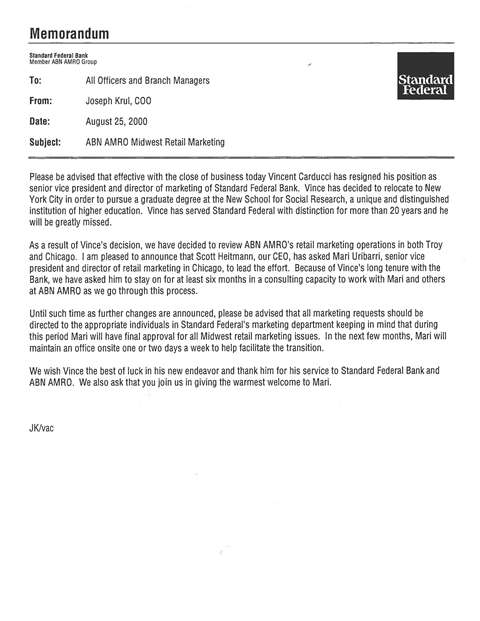
|
‘Getting Over’ Over and Out, part 2, 2000
photocopy
11” x 8 ½”
|
figure 12
|
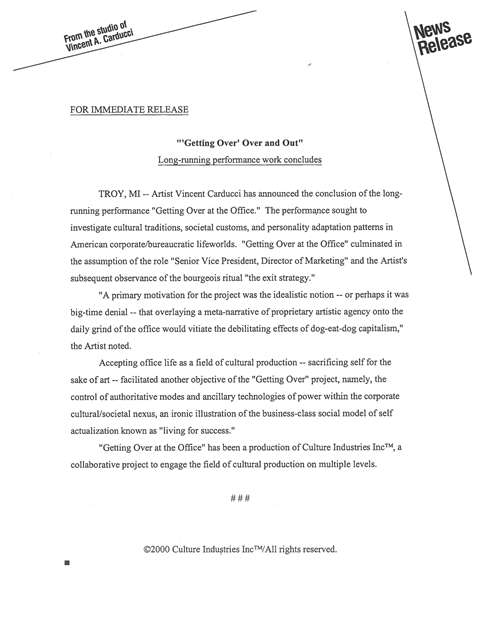
|
‘Getting Over’ Over and Out, part 3, 2000.
photocopy
11” x 8 ½”.
|
The final gesture was to conclude the performance when I decided to quit my job and return to grad school. The last piece,
‘Getting Over’ Over and Out, 2000, has three parts: my letter of resignation to my then boss the Chief Operation Officer, my memo ghostwritten for the COO announcing my resignation and the company’s plan of succession and the final news release announcing the end of the performance. Again, the question of identity is at play in that each of these documents, written in a different voice for a different audience, are all composed by the same individual. In a certain sense, partitioning is, to some extent, a survival mechanism many of us have in navigating the treacherous terrain of the postmodern world. To be sure, the subtitle of
Gilles Deleuze and Felix Guattari’s two-part masterwork, “capitalism and schizophrenia,” pretty much says it all. And that, in a nutshell, is how I got over.

















